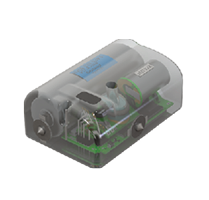
Wildlife Computers Time-Depth Recorders (TDR) are data-archiving tags designed for tracking fine-scale movements of marine animals. A TDR10 is a cost-effective tag that works best on animals that can be captured twice such as pinnipeds, sea turtles, and penguins.
Overview
The TDR10 tags come in a variety of shapes with a variety of sensor options for gathering sample data including depth, temperature, light, wet/dry, acceleration, and stomach temperature (using the stomach temperature pill linked to a TDR). TDR10 tags can also come equipped with Fastloc® GPS. Fastloc acquires highly accurate locations in under a second.
Key Benefits of TDR10 Tags
- Fine-scale, high-resolution sample data
- High-sample rates
- Best possible digital resolution
- Most complete data set
- Highly accurate locations
- Fast acquisition
- Stored GPS snapshots
- Flexible scheduling
- Hundreds of achievable location per day
Data Products
Different tag models offer different data products.
Available Data Products | |||||
| Depth Archive | ✓ | ✓ | ✓ | ✓ | |
| Temperature Archive | ✓ | ✓ | ✓ | ✓ | ✓ |
| Light Archive | ✓ | ✓ | ✓ | ✓ | |
| Wet/Dry Archive | ✓ | ✓ | ✓ | ✓ | ✓ |
| Acceleration 3-Axis Archive | ✓ | ✓ | ✓ | ||
| Stomach Temperature Archive | ✓ | ||||
| Fastloc Archive | ✓ | ✓ |
Recovery Options for TDR Tags
- Payload Recovery Device—a great way to recover data with minimal effort and disturbance. From over 200 m away, the Payload Recovery Device will detach from the animal with a radio command.
- Float Packages—if you cannot recapture your animal another option is to attach the TDR10 to a float package that will release from the animal and then recovered. For example, a suction cup attachment on a cetacean. A SPOT tag, like our Asset Recovery tag, can be used to assist in finding the float package.
- Asset Recovery Tag—A SPOT tag can be attached to the animal in order to locate it, recapture it, and recover the TDR10. This tag can also be incorporated into a float package that holds the TDR10.
User Guide/Software
This user guide gives you all the essential information needed for interacting with, configuring, and deploying this tag.
USB Communications Cable Driver – 29-March 2023
Driver for the Wildlife Computers USB-Blue communications cable.
Use Mk10Host for configuring legacy SPLASH tags – Version: 1.27.0002 16-Feb-2024. You must remove any prior versions before downloading.
Installs the Mk10Host program used for communicating with TDR tags. Mk10Host allows you to set up the tag’s deployment parameters and download archived data when the tag is recovered.
Wildlife Computers Data Portal—reliable, complete cloud storage for your data.
Tag Portal—convenient online programming for configuring tag settings.
A statistical model for estimating animal movements. GPE3 is an integrated Wildlife Computers Data Portal component and runs exclusively on our servers.
Specifications
The TDR10 is configurable with a wide variety of sensors. Fastloc® GPS is available on several configurations.
Below are the general physical specifications of TDR10 tags.
| Attachment Type | Externally mounted*** |
| Sensors | Depth, Temperature, Light-level, Wet/Dry, 3D Accelerometer, Stomach Temperature, Fastloc GPS*** |
| Depth Sensor Range | 0-1700 m, 0-2000 m*** |
| Depth Sensor Resolution | 0.5 m, 1 m*** |
| Depth Sensor Accuracy | ± 1% of reading |
| Temperature Sensor Range | -40° C to 60° C |
| Temperature Sensor Resolution | 0.05° C |
| Temperature Sensor Accuracy | ± 0.1° C |
| Light Sensor (When Installed) | 5 x 10-12W cm-2 to 5 x 10-2W cm-2 |
| 3D Accelerometer Range | ± 2 g |
| 3D Accelerometer resolution | 0.05 m-2 |
| Stomach Temperature Resolution | ± 0.1° C |
| Stomach Temperature Accuracy | ± 0.3° C |
| Maximum Sampling Rate | 32 Hz |
| Pressure Rating (m) | Up to 2000 m |
| Operating Temperature Rating (°C) | -20° C to 50° C |
| Optimal Storage Temperature Range (°C) | 0° C to 5° C |
| Conductivity Operational Limits | 0.1 S m-1 to 5 S m-1 |
| Memory | 1 GB |
| Length, Width, Height, Weight, Wet/Dry Sensor, Maximum Deployment Length | *** |
*** indicates the specification is dependent upon the configuration model
